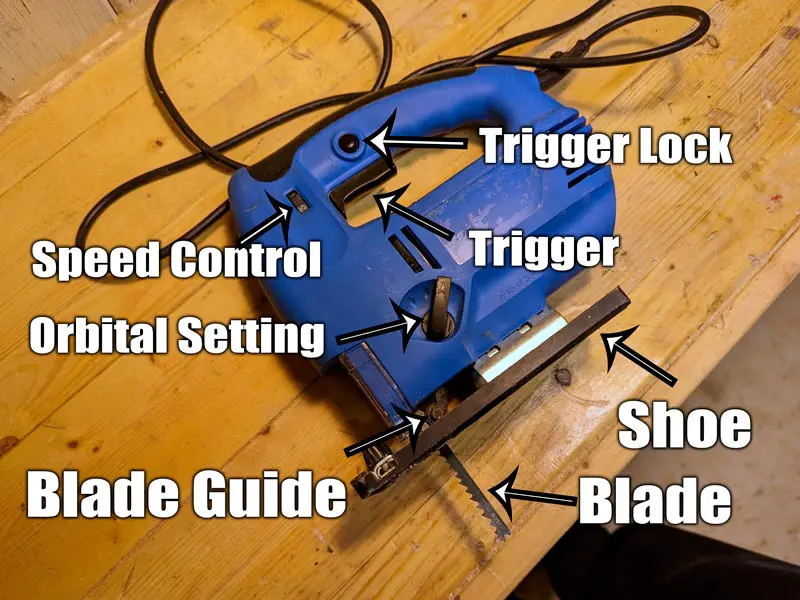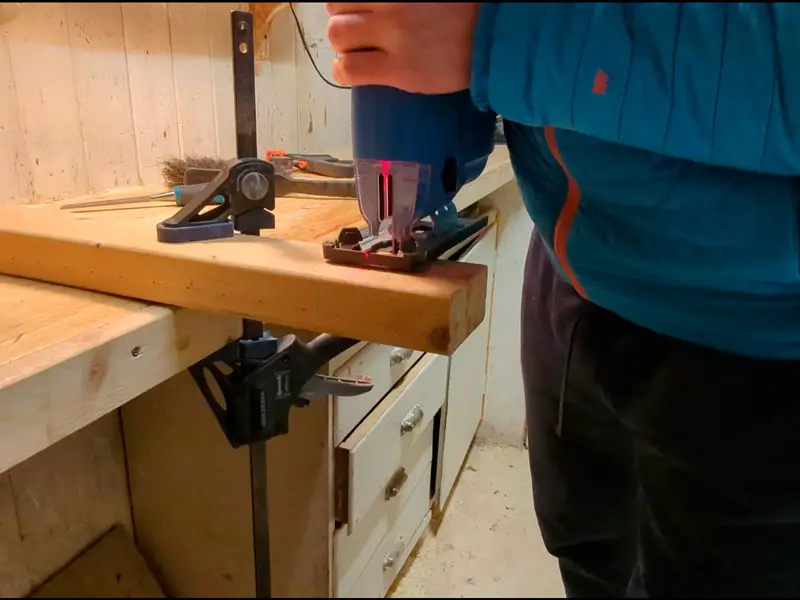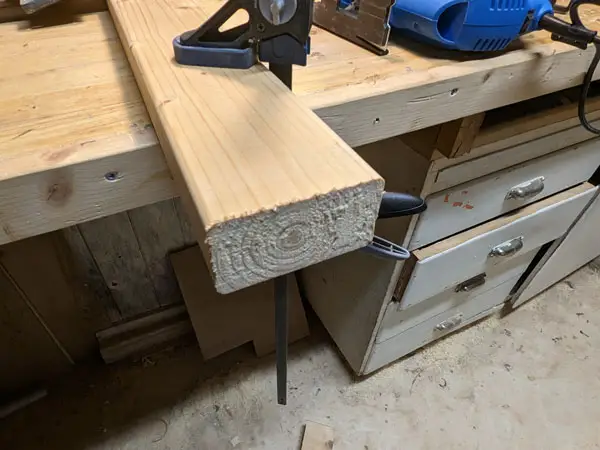
What is a Jigsaw?
A jigsaw is a handheld power saw that can cut a wide range of different materials by cutting in a reciprocation motion. A jigsaw is one of the most versatile power saws and it is great for doing quick cuts, curved cuts, and odd cuts that other saws are not able to do.
A jigsaw is small and portable, it is easy to transport and use in different locations, and it is powered by electricity, some models use a wall plug, while other models use a battery for power.
What Materials Can You Cut With A Jigsaw?
A jigsaw can cut more materials than you would expect. But a jigsaw is generally used for cutting wood, metal, and plastics.
Here are some of the materials you can cut with a jigsaw:
Solid Wood – A jigsaw is a very good tool to cut through solid wood. It is my go-to tool if I just have to make a quick cut in a piece of lumber.
Engineered Wood – Engineered wood is wood like plywood, MDF, OSB, or chipboard. A jigsaw will be able to cut through all of these. The great thing about a jigsaw is that you are able to bring the saw to the wood instead of bringing the wood to the saw.
This makes handling these big sheets of materials much easier.
Metal – A jigsaw does a fairly good job of cutting metal. It is especially good at cutting those odd shapes in big metal sheeting that you are not able to make with a metal bandsaw or circular saw.
Ceramic Tile – You are also able to cut ceramic tile with a jigsaw. Now again, the jigsaw is good for cutting those odd shapes that will be hard to cut with a tile cutter or a wet saw. For straight cuts, a tile cutter will be much faster.
Plastic – A jigsaw makes quick work of most types of plastic. You can cut plexiglass and PVC very effectively. A jigsaw works best for cutting flat pieces because of how the tool rests, but it will have no problem with cutting a PVC pipe.
Laminate – A jigsaw is a great tool for cutting laminate, the thin material makes it easy to cut. But it can be hard to achieve clean edges with a jigsaw.
Drywall – A jigsaw will have no problem cutting through drywall. It can be great for making those odd cuts, for example, to make an opening for an electrical box
Parts Of A Jigsaw

Shoe – The shoe of a jigsaw is used to rest against the material you are cutting. You can adjust the shoe on most jigsaws to change the cutting bevel up to 45 degrees
Blade Holder – The blade holder holds the blade in place. Most modern jigsaws have a quick change system so you can change the blade in 2 seconds.
Blade – The blade does the cutting. The blade is supposed to be facing away from sharp angles of the blades pointing upwards. Since a jigsaw generally cuts on the upstroke.
Blade Guide/Roller – The blade guide supports the blade and reduces the movement of the blade during the cut. This ensures a cleaner cut.
Trigger – We hold down the trigger to start the jigsaw, and initiate the cutting motion. Some jigsaw does not have a conventional trigger, they just have an on and off button.
Trigger lock – A trigger lock is used by some jigsaws to lock the trigger button if you want to continually cut for a long time. The jigsaw will keep cutting until you turn off the trigger lock.
Handle – Some jigsaws have barrel handles and some jigsaws have top handles. The one you see in the image above is a top-handle jigsaw. I prefer using a barrel handle jigsaw personally.
Orbital Switch – All modern jigsaw has an orbital setting. This is usually a switch on the side that goes from 0(off) to 3. The orbital setting adjusts how aggressively you want the blade to cut. 3 being the most aggressive.
Speed Control – The speed control is usually a roller, but the number of different speeds varies. My jigsaw goes from 1(low) to 7 (high).
Jigsaw Settings
There are two settings that are really important to know about when you want to cut anything with a jigsaw. And that is the orbital setting and the speed setting. So let us dive a little bit deeper into these two.
Jigsaw Orbital Setting
The orbital setting adjusts how aggressively the blade will cut. A jigsaw will usually just cut in an up-and-down motion, but when you turn on the orbital setting it also is pushed a little bit forward while cutting, this creates an orbital motion.
Orbital Settings on max = Rougher Cut, but faster cut
Orbital setting off = Cleaner Cuts, but slower cuts
I set my orbital setting to the max setting when I want to cut pallet wood quickly and roughly, for example, to use as firewood.
I set my orbital setting to OFF when I need to make a clean cut in laminate flooring to use in my house.
Speed Setting
The speed setting will adjust how fast the blade will go up and down. This is usually adjusted with a roller on either side of the tool. A higher number will equate to faster speeds, and a lower number will be slower. You can change the cutting speed while the jigsaw is running on most jigsaws.
For some materials and cuts, we want to use a faster speed, and for some materials and cuts, we want to use a slower speed.
When we are cutting hard metal, we usually want to reduce the speed to avoid overheating the blade and the material we are cutting. The same goes for other hard materials like tile.
When rough-cutting softer wood, we usually want to use a higher speed setting to make the cutting go quicker.
Which Jigsaw Blade Should You Use?

We use different jigsaw blades for cutting different materials.
A jigsaw blade for cutting wood has completely different characteristics than a blade for cutting metal.
Jigsaw blades will usually have written on them what they are supposed to be used for. And usually, if you just follow what the blade says, you are going to be fine.
But there is so much information about jigsaw blades that the topic deserves its own article. So here is a Complete Detailed Guide To Choosing The Right Jigsaw Blade!
Or just read the summary below.
Jigsaw Blades For Wood – Jigsaw blades for wood are usually made of High Carbon Steel (HCS). This is written on the blades of wood. HCS blades are flexible but not that durable. Wood cutting blades have a low tooth count (TPI) and will be more aggressive than for example metal blades.
Jigsaw Blades For Metal – Jigsaw blades for metal are usually made of High-Speed Steel (HSS). This is written on the blades for metal. HSS blades are not that flexible, but they are very hard and durable. Metal-cutting blade has a higher tooth count (TPI) and will be less aggressive than wood-cutting blades.
Jigsaw Blades For Harder Materials Ex. Tile – Jigsaw blades for harder materials like tile will be made with carbide coating glued to the cutting edge. Carbide is a very hard material that can cut through almost anything. Some jigsaw blades can also have carbide teeth for cutting through thicker pieces of metal.
Jigsaw blades can also be made from Bi-metal, blades from Bi-metal incorporate strengths from both HSS and HCS jigsaw blades and are more durable than both HCS and HSS jigsaw blades.
My advice for anyone that is starting out with a jigsaw is just to get a set of multiple different jigsaw blades. Like This Set Right Here On Amazon! These sets have aggressive blades for wood, clean blades for wood, and also blades for cutting metal.
Changing Jigsaw Blades
Changing blades on modern jigsaws is very simple, they usually have a lever on the front or the side that you can pull. This rotates the blade holder about 45 degrees and the blade pops out. Now you can insert the new blade and let go of the lever. The jigsaw is then ready to be used.
Here is an article that goes into detail about the topic, some jigsaws can be different from the explanation above.
Article: How To Change Jigsaw Blade – T-Shank And U-Shank
How To Cut With A Jigsaw – The Basics

Cutting with a jigsaw has a steep learning curve. It can be a little bit intimidating the first time you use it, but a jigsaw is not that hard to control, and you will get used to cutting with it very quickly.
If it is your first time cutting with a jigsaw, I recommend starting off by cutting some straight and flat wood. Some plywood or some construction lumber is great to practice on.
We want a flat object to cut so the shoe of the jigsaw can rest firmly on it, cutting uneven shapes are generally harder to cut.
The object you are cutting can be secured with clamps to reduce movement, this gives us more stability and one less thing to think about when cutting.
Put on some safety gear before you start cutting, protection glasses should always be used when cutting with a jigsaw. Hearing protection and gloves are optional.
Make sure you have the right jigsaw blade, in this case, we want to use an HCS blade for wood.
Set your jigsaw to the preferred settings, in this case, we can try to set the speed control to somewhere in the middle, and the orbital action to 0 (off)
Before you start cutting you want to start the jigsaw and let the blade get up to speed. Do not start the jigsaw while the blade is in contact with the material you are cutting.
When the blade is at the proper speed, you can slowly approach the material you are cutting with the running blade. In the beginning, you just want to get a feel for how the jigsaw reacts when you cut into the wood.

There is going to be some vibration when cutting, the amount of vibration depends on how well the object is secured. If the object you are cutting is far away from the supporting surface, then there is going to be more vibration.
Now, just practice with the jigsaw and make some cuts.
The most important tip I have for you is to let the tool do the work. A jigsaw does not work very well if you try to force it through the cut, this will make the blade deflect and the cut will get crooked.
If you force the cut in metal, the blade will overheat and both the metal and the blade will be ruined.
And if you are using a jigsaw with a cable, then always be mindful of where the cable is. I have heard about people cutting off their power cables because it is hidden underneath the object they were cutting.
What Types Of Cuts Can You Make With A Jigsaw?
A jigsaw excels at making curved cuts, rough cuts, and odd shapes that other saws have a hard time cutting. You can easily cut circles in plywood with a jigsaw, you can cut curves in metal, and you can make a V-cut in tile. These odd shapes are what the jigsaw is best used for cutting.
Whenever I need to cut out a shape that is not straight, I use the jigsaw.
A jigsaw is also great for disassembling pallets, I use my jigsaw all the time for this. It is great for rough-cutting the edges of planks on the pallet, so you do not have to pull out all the nails from the boards.
Can You Cut Straight Cuts With A Jigsaw?
You can make straight cuts with a jigsaw, but it will be harder to achieve a clean and straight cut with a jigsaw than with for example a circular saw. To make a clean and straight cut with a jigsaw you want to use some sort of cutting guide, you want to use a high-quality blade and a high-quality jigsaw. Set the orbital setting to 0, and do not force the jigsaw through the cut.
Here Is A Guide On How You Achieve Straight And Clean Cuts With A Jigsaw!
What Is The Thickest Piece Of Wood You Can Cut With A Jigsaw?
The thickest piece of wood you can cut with a jigsaw will depend on the size of the blades available and the power of the jigsaw. You can find jigsaw blades that are able to cut through wood that is 6 Inches thick, or 15cm.
You can check out this large jigsaw blade here on Amazon!
What Is The Thickest Piece Of Metal With A Jigsaw?
A jigsaw is not the most effective tool for cutting metal and is best used for cutting thinner pieces of metal. The most jigsaw effective jigsaw blades for metal will be able to cut through metal that is 1/4 Inches thick, or 6.3mm.
Why Everyone Should Own A Jigsaw
A jigsaw is one of those tools I think everyone should own. Every home should have one because the tool is just so extremely useful. For any task like cutting up firewood, cutting up trash products in smaller pieces, renovation, or cutting a PVC pipe. The jigsaw is can do it all and it is extremely versatile.
What Is A Good Mid-Range Jigsaw
A good mid-range jigsaw that I can recommend is the BOSCH 7.2 Amp (Amazon). This is a reliable jigsaw and it is very user-friendly. It also has a barrel grip, which I prefer over the top handle jigsaws.
That was it for this article, and hopefully, the mystery around jigsaws is a little less of a mystery after reading this article. Thanks for reading to the end, have a wonderful day.
